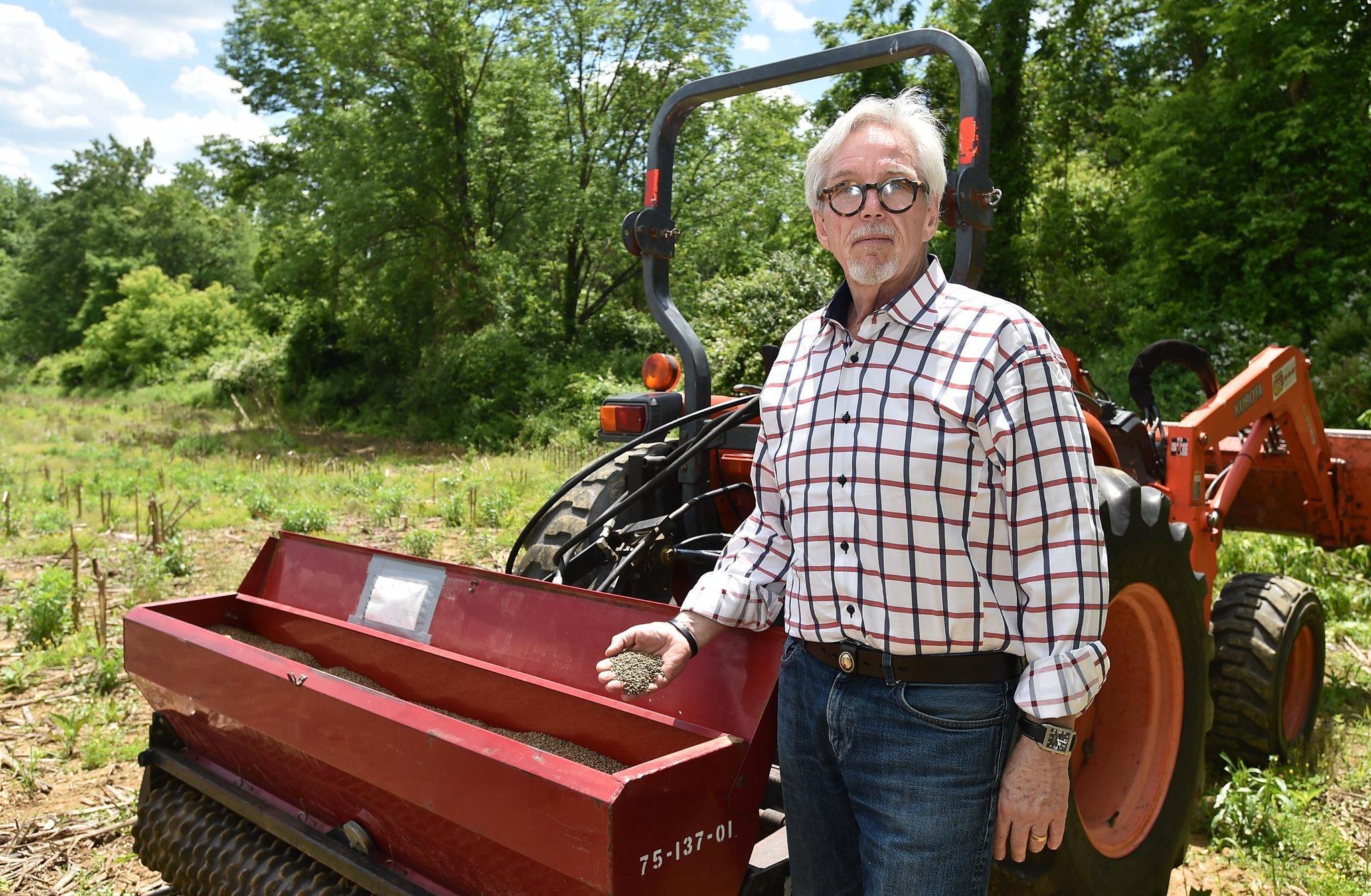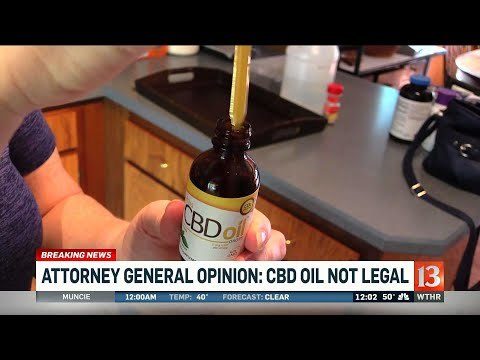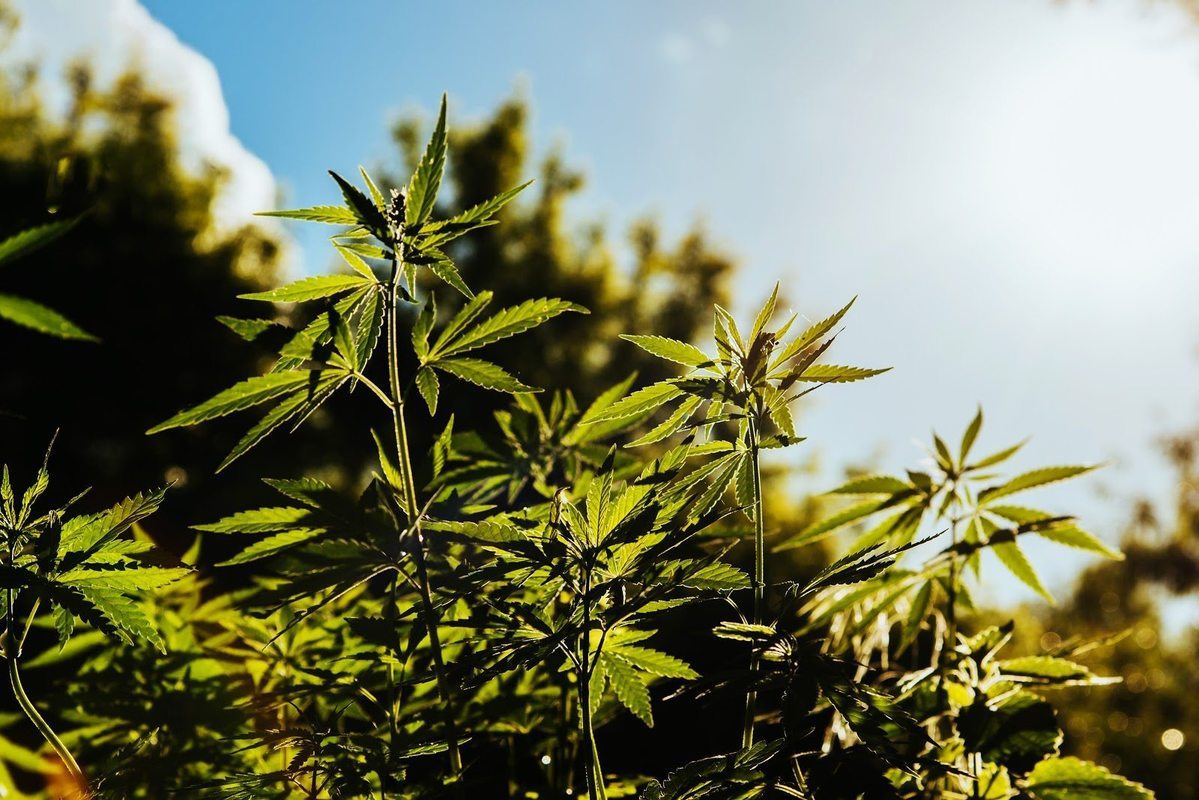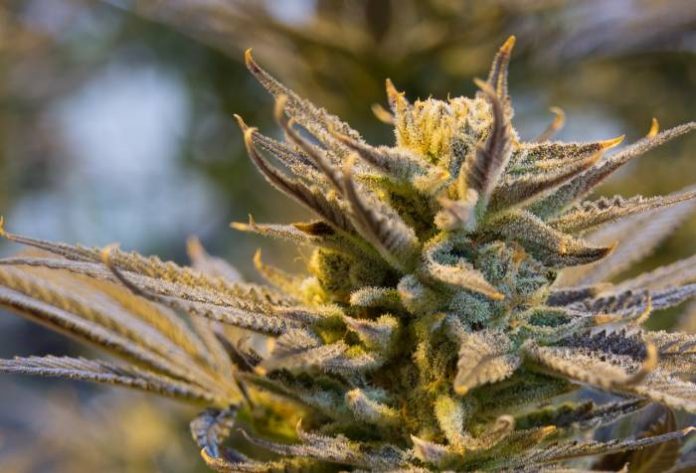By
Andrew WagamanSource:
mcall.com Geoff Whaling, president of the Pennsylvania Hemp Industry Council, holds hemp seeds before planting on Lehigh University property in Upper Saucon Townsip in June. (APRIL GAMIZ / THE MORNING CALL)
Geoff Whaling, president of the Pennsylvania Hemp Industry Council, holds hemp seeds before planting on Lehigh University property in Upper Saucon Townsip in June. (APRIL GAMIZ / THE MORNING CALL)If you believe the enthusiasts, industrial hemp could be the comeback story of our time — one worth tens of billions of dollars, maybe more, if only given a chance.
Potential mainstream uses abound for the plant, a primary cash crop as clothing, oil and rope from the time of Pennsylvania’s founding in 1681 to the mid-19th century but a casualty of the indiscriminate war on the cannabis plant. Just a sampling of the new uses: Beauty products. Car parts. Building materials and housing insulation. Energy storage devices for electronics. Pest resistance and weed suppression.
And seriously: It does not get you high.
Now, as legal and cultural barriers begin to fall, regional advocates are confronting perhaps the most difficult hurdle: developing from scratch the institutions and supply chain to sustain a stable market.
Thanks to the expanded parameters of a state-run hemp pilot program, Lehigh University, Jefferson University and the nonprofit Pennsylvania Hemp Industry Council are exploring an ambitious partnership aimed at becoming a matrix for the nascent U.S. industry.
The research alliance — yet to be formalized, both universities emphasized — would seek a federal “center of excellence” designation, giving it first dibs on some pots of U.S. Department of Agriculture funding. It also hopes to establish a relationship with international companies that own the distinctive harvesting equipment and processing technology needed to develop a commercially viable market — which in turn could attract established businesses, entrepreneurs and investors who are interested in the industry but remain on the sidelines.
It could ultimately deliver an economic boon for the Lehigh Valley and southeastern Pennsylvania. Geoff Whaling, president of the Pennsylvania Hemp Industry Council and chairman of the National Hemp Association, led a coalition this month to Europe, where it made a business pitch to HempFlax, a multinational processing company in the Netherlands that has an eye on the U.S. market.
The company appreciated the holistic approach Lehigh and its partners are taking, said Cameron McCoy, assistant vice president of economic engagement at Lehigh. Rather than merely selling equipment, HempFlax could gain from the alliance’s research endeavors as well as its relationship with manufacturers in the region.
Whaling, of Berks County, said the company needs at least 3,000 acres of hemp to make an investment worthwhile. He’s hoping to get commitments from regional farmers by the Jan. 19 deadline for state pilot program research proposals to show that the alliance is more than just talk and can support a proposed industrial hemp research park in Upper Saucon Township.
“I can’t tell you how excited I am for Pennsylvania and its farmers,” Whaling said. “We have farmers with anywhere from two acres to 750 acres who have expressed interest, and the list keeps growing. But we are trying to move quickly.”
HempFlax did not respond to a request for comment.
Holistic approach to hempIndustrial hemp is the straight-laced sibling of marijuana. Both come from the same fibrous cannabis plant, but hemp has a negligible amount of the psychoactive substance that gets you high — delta-9 tetrahydrocannabinol, or THC.
The market has grown despite continued legal constraints. Imports of hemp, seeds and fibers, used as ingredients or inputs for further manufacturing, reached nearly $78.2 million worth in 2015, up from $5.6 million in 2005, according to industry estimates cited in a 2017 U.S. Congressional Research Service report. Those imports contributed to U.S. retail sales of hemp products of nearly $600 million in 2015.
To understand the best possible future of industrial hemp, consider the petroleum refinery, says Ronald Kander, dean of Jefferson’s college of design, engineering and commerce, and associate provost of applied research.
Refineries are not built to process crude oil for a single use, such as gasoline — that wouldn’t be economically viable. Instead, crude oil is converted into numerous high- and medium-value products.
Refineries are massive capital investments, so investors need the ability to calculate the time and resources it will take to make a given product and how much value each given product will create.
For the hemp industry, this leads to somewhat of a chicken-and-egg problem. Before farmers commit to the larger-scale growth of hemp needed to underpin a commercial market, they need to know they can make money on the crop. That requires buyers.
Holistic research can help bridge the divide. Right now, Kander says, no institutions are taking a systematic approach to researching the relative values of products derived from hemp’s fiber, seed, stalk and hurd (the inner portion of the stalk).
“It’s an integration problem,” he said. “The hemp industry will only be successful if made in the vision of the refinery model.”
While hemp-derived products could theoretically serve as alternatives in dozens of industries, researchers want to figure out which applications make the most economic sense to develop, Kander said.
There are four key questions: Does the hemp-derived product actually outperform what’s currently used? Is it less expensive to produce? Is it more environmentally sustainable? Will the consumer look past hemp’s relationship to marijuana?
Kander thinks two affirmative answers are probably needed to make development worthwhile.
Jefferson, which recently merged with Philadelphia University, launched the Lambert Center for the Study of Medicinal Cannabis and Hemp last year thanks to a donation from an Australian banker, who also brought the industrial hemp company Ecofibre to Kentucky. Jefferson considers its expertise in medicine and applied research harmonious with Lehigh’s engineering strengths. Both have supply chain management programs.
Kander envisions the alliance as a gatekeeper and “point guard” of the industrial hemp research ecosystem. It would pre-vet other regional universities with complementary research specialties seeking the benefits of the “center of excellence” designation. As more businesses explore hemp’s innovative possibilities, they would turn to the Lehigh-Jefferson anchor directly for information or resources, or as a guide to the right expert.
Lehigh and the Hemp Industry Council partnered on three of the 16 approved hemp research projects statewide last year. The projects examined hemp's ability to remediate metal-heavy soils at sites where mining or other industrial activities occurred, antimicrobial compounds extracted from hemp and production of graphitic carbon nanosheets from hemp fiber.
Lehigh researchers once specialized in the supply chain of the steel industry because of its close relationship with Bethlehem Steel, and McCoy thinks the university has the right institutional assets, such as the ATLSS Engineering Research Center, to develop a leading role in the hemp industry.
The Lehigh Valley also is an attractive location to develop the hemp industry, McCoy said, because of its still-considerable farming capacity and for the same reasons the region has become a distribution hub: it’s a relatively short drive to many major markets.
The resurgence of its manufacturing sector and the growth of its food processing sector also present the opportunity for research and development collaborations down the road, Whaling said.
“There’s such potential to really utilize all the opportunities and industries in greater Lehigh Valley to do this,” Whaling said.
Legal progress
State and federal restrictions still need to change before the industry can thrive commercially.
Following the 2014 Farm Bill, the federal government permitted the cultivation of hemp for research, and some states have decided such research should include commercial endeavors. Farmers can grow industrial hemp for commercial purposes in at least 20 states, according to the National Conference of State Legislatures.
The Pennsylvania Legislature passed a law enabling a hemp pilot program in 2015, and the Wolf administration launched the program late last year. It decided not to allow cultivation for commercial purposes and limited research projects to five acres, provoking the ire of advocates like Whaling and some small-scale farmers who saw no economically viable way of growing the crop.
In 2018, general commercial activity remains prohibited, but the state now allows individuals to grow up to 100 acres of hemp and research cannabidiol (CBD), a molecular compound that won’t get you high but does have medicinal value. Perhaps the most promising change for the industry: Individual applicants who partner with institutions of higher education can grow as much as they want — well beyond the three acres of Upper Saucon land where Lehigh and the Hemp Industry Council planted seeds in June.
Fred Strathmeyer, the agriculture department’s deputy secretary for plant industry and consumer protection, said most program participants last year were satisfied with the five-acre limit because they wanted to “walk before they run.” But they listened to feedback from participants who felt the acreage limit constrained market research.
“We have now given them the platform they were looking for to build on their previous experiences and accomplish different tasks,” he said. “We are excited to see what comes of it.”
Legal barriers remain. The federal Controlled Substances Act still classifies hemp under its broad, archaic definition of marijuana as a drug with no accepted medical use and a high potential for abuse. This complicates interstate commerce and blocks access to financial services.
But a proposed bill in the U.S. House of Representatives, co-sponsored by three members of the Pennsylvania congressional delegation, would exempt hemp from CSA regulations. Rep. Ryan Costello, a Chester County Republican, said the bill is a commonsense measure supported by representatives across the ideological spectrum and will hopefully be adopted as part of the next Farm Bill, expected in 2018 or 2019.
Two other bills would ensure federal regulators don’t go after banks and other institutions providing financial services to legitimate cannabis-related businesses or, more narrowly, legitimate industrial hemp businesses.
“This is a totally noncontroversial issue but for the fact that people associate it with marijuana,” Costello said.
THE RETURN OF HEMPPennsylvania Department of Agriculture's new and expanded provisions:
Acreage: Individual applicants can grow up to 100 acres, up from a five-acre maximum in 2017. Applicants that partner with an institution of higher education on a coordinated research project have no acreage restriction.
CBD: Applicants can now conduct research projects related to the extraction or production of cannabidiol and other chemicals concentrated in the female flower of the cannabis plant. CBD is similar to THC but lacks its psychoactive effect. In other words, CBD can't get you high.
Administrative fee: $2,000, down from $3,000 last year.
Maximum permitted projects: 50, up from 30 last year.








 How Hemp Works
How Hemp Works/files.merryjane.com/uploads/article/hero_image/6015/Front_Range_Q_A_WIDE.jpg)
/files.merryjane.com/uploads/ckeditor/pictures/2946/content_fantastic-sams-test-photos-14-1080.jpg)
